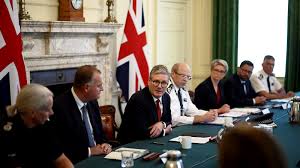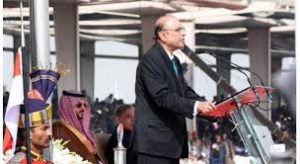Britain’s anti-immigrant riots pose critical test for starmer

London: With cars being torched and mosques and hotels housing asylum seekers under attack, the riots that swept Britain over the past two weeks have posed the first direct challenge to the new prime minister, Keir Starmer.
But even if the violence has subsided, for now, at least, the shocking scenes of disorder have underscored the scale of the task facing his government.
That, analysts say, includes defusing tensions stoked successfully by far-right groups — over immigration and fraying public services — particularly in areas of Britain that have long been in economic decline.
While opinion polls show the public clearly supports Mr. Starmer’s crackdown on violent protesters, “a lot of those people who see the rioters as thugs want immigration brought down,” said Steven Fielding, an emeritus professor of political history at the University of Nottingham.

Mr. Starmer, who has promised to cut migration numbers, “needs to follow up and do the things he says he’s going to do,” Professor Fielding added, while noting that it was “no accident” that violence erupted in several economically deprived regions.
Concern over immigration, which declined in Britain after Brexit, is on the rise again and, when jobs are scarce and health care and other services are overstretched, immigrants make an easy target for the far right. The campaign leading up to last month’s general election prompted a bitter political dispute over the last government’s plans to send to Rwanda people arriving in Britain on small boats.
But while around 30,000 people entered the country that way last year, that was only a fraction of those admitted legally minus those who left — a number that hit almost 750,000 in 2022.
Four people in bright yellow vests that say “police” wear helmets and carry shieldlike objects. Three of them use the shields as they surround a person pushing back. The fourth approaches a crowd that looks on.
The police engaging with a man during an anti-immigration riot this month in Rotherham, England, where a hotel housing some asylum seekers was attacked.Credit…Danny Lawson/Press Association, via Associated Press
Sunder Katwala, the director of British Future, a research institute, said Mr. Starmer must show he can revive neglected areas where the rightists have found support by bolstering employment and public services.
“He needs to deliver,” Mr. Katwala said, “for those town and cities — whether it’s Southport or Hartlepool — where people’s primary concerns are National Health Service waiting lists and ‘Can I get a job?’”
Those close to Mr. Starmer say he is getting a grip on the disorder, drawing on his experience as a chief prosecutor in 2011, when riots took place in London and he pushed to get those responsible tried, sentenced and jailed swiftly to deter others.
“He has a detailed knowledge of how to do this, and he understands how you prosecute and convict quickly, and you do so visibly in a way that sends a message to anybody who is thinking about participating in one of these riots,” said Claire Ainsley, a former policy director for Mr. Starmer.
But ensuring that such violence does not recur is harder, she said.
“We have had the far right with us in good economic times and in bad economic times,” said Ms. Ainsley, who now works in Britain for the Progressive Policy Institute, a Washington-based research institute.
“But it is much harder for them to have any kind of influence when you are in better economic times,” she added. “That means people’s living standards rising and people starting to feel they are better off and that they are part of a system that is working — and that isn’t a description of Britain today.”
Ms. Ainsley pointed to the role of social media in spreading misinformation and stoking tensions, and cautioned against making a direct link between the riots and immigration. She noted that, alongside extremists, some of the rioters may be looters and other opportunists.
It is, she added, “wrong to assume that all of the people participating in these riots are politically motivated by immigration.”
Still, other analysts note the context of the riots, after years of broken promises to reduce immigration and the contentious dispute over the last government’s doomed effort to send some asylum seekers to Rwanda.
They were a particular target of the recent anti-immigrant riots, including in Rotherham, England, where a hotel housing some asylum seekers was attacked on Aug. 4, driving home the severity of the disorder.
Launched by a former prime minister, Boris Johnson, in 2022, the Rwanda plan was adopted as a flagship policy by Rishi Sunak, who entered Downing Street later that year. The courts ruled against the proposal, and despite months of political maneuvering, no asylum seekers were sent to Africa under the plan. After taking office, Mr. Starmer quickly scrapped the effort.
But Mr. Katwala said that by pledging to “stop the boats,” Mr. Sunak had drawn attention to the issue, sending “very loud messages” about how much control he would exert over national borders while delivering none. The result, Mr. Katwala said, was to “stoke up the level of concern over the issue, and completely fail on all fronts.”
By global standards the scale of small-boat arrivals is relatively modest and “the visible lack of control is much more the issue than the number of people coming via that route,” Mr. Katwala said.
While Mr. Starmer can try to lower the political temperature, his practical options for curbing English Channel crossings are limited. He plans to crack down on people-smuggling gangs, but, unless Britain strikes a new migration deal with France, recent experience suggests that step alone is unlikely to resolve the problem.
One thing the government intends to do is to speed up the system for processing asylum requests to cut the number of would-be refugees accommodated in hotels at public expense — a source of grievance to anti-immigrant protesters. (Asylum seekers tend to be accommodated in less wealthy areas where hotel costs are lower, making them a particular target in the recent riots.)
The fact that many more people have been allowed to enter the country legally has created another issue that has been weaponized by the far right, presenting Mr. Starmer with another big challenge.
An inflatable dinghy filled with people wearing bright orange life jackets makes its way through open water.
Successive Conservative governments promised but failed to reduce annual legal net immigration to below 100,000, and control of the country’s frontiers was a key issue in a 2016 referendum in which Britons voted for Brexit.
Still, since Brexit, legal immigration has tripled, falling back only slightly from its 2022 peak — the highest on record.
Those figures were inflated by programs to accommodate people from Ukraine, Hong Kong and Afghanistan, for which there was wide public support. But Britain also relies heavily on foreign workers to fill jobs in health care and other sectors, and immigration is a driver of economic growth, so cutting it is hard.
“There is broad support for all the immigration that generates the very high numbers,” said Mr. Katwala, noting that most people welcomed Ukrainians and are happy for foreign workers to fill vacancies in British hospitals, “but then concern about the scale of the number.”
Before losing last month’s general election, Mr. Sunak tightened the migration rules, restricting the right of some legal immigrants to bring relatives to Britain. Those changes are expected to push down the numbers over the next year.
Reducing them further will be difficult without damaging health care and other key sectors, or impeding Mr. Starmer’s central objective of reviving the economy to ease Britain’s cost of living crisis. The recent unrest suggests that lifting economic growth, reviving neglected cities and investing in crumbling public services have never been more important.
The riots are “not telling this government anything it didn’t know,” Professor Fielding said. “They are just making its task more urgent.”





